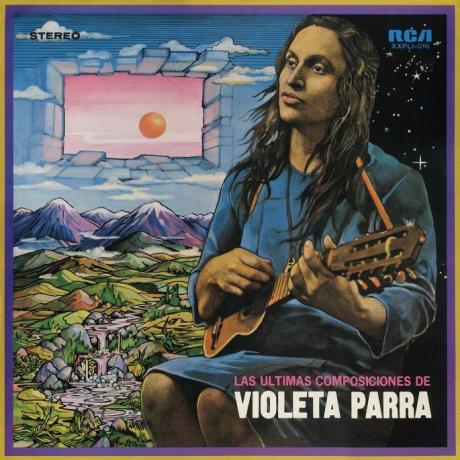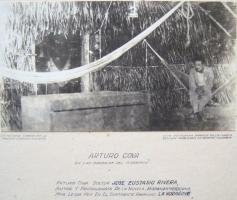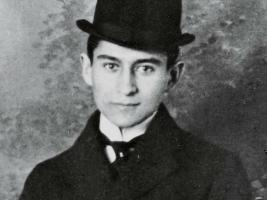Song Gracias a la vida by Violeta Parra: lyrics, analysis and meaning
"Thanks to life" is a song that has entered the hearts of many to stay. Originally composed and recorded by Violeta Parra, and included in her album The latest compositions From 1966, this song has become a reference not only for Latin America, but for the entire world.
The song is not without its mystery. Speculation about the message that Violeta Parra wanted to convey has not stopped since she committed suicide in 1967, a few months after having published what she was, in her own words, her album, her most mature and more careful. After all, they wonder, why would someone grateful to life leave it in this way?
Lyrics

Thanks to life, which has given me so much
She gave me two stars, that when I open them,
I perfectly distinguish black from white,
and in the high sky, the starry background of it,
And in the crowds, the man that I loveThanks to life, which has given me so much
Has given me the ear that in all its width
Record crickets and canaries night and day
Hammers, turbines, barks, showers
And the tender voice of my belovedThanks to life, which has given me so much
It has given me the sound and the alphabet
With him, the words that I think and declare
Mother, friend, brother, and light shining
The path of the soul of the one that I am lovingThanks to life, which has given me so much
He has given me the march of my weary feet
With them I walked cities and puddles
Beaches and deserts, mountains and plains
And your house, your street and your patioThanks to life, which has given me so much
Gave me the heart that shakes its frame
When I look at the fruit of the human brain
When I look at the good so far from the bad
When I look at the bottom of your clear eyesThanks to life, which has given me so much
He has given me laughter and has given me crying
So I distinguish happiness from brokenness
The two materials that make up my song
And the song of you that is the same song
And everyone's song that is my own songThanks to life, thanks to life
Analysis

"Gracias a la vida" is the theme that opens the album called The latest compositions scored by Violeta Parra. From the formal point of view, we can describe a series of elements. The music is composed in a minor key that, together with the accompaniment of charango and percussion, underline an intimate and melancholic character.
With an almost naked voice, Violeta Parra introduces the main motif of the piece: the phrase from the text "Thanks to life that has given me so much." The text is structured in a total of six stanzas, each of which contains five twelve-syllable verses, except for the last one, which has six verses. At the end, she adds a single verse in which she repeats "thanks to life, thanks to life." Each verse returns on the same melodic line and harmonic structure.
Those things that the author reviews as a summary of her treasures are those that go unnoticed by our thinking or our culture. What life has given him, it has given him from the beginning: eyes, ears, sounds and words, feet (the march, the road), heart, laughter and tears, these last two "material" of his song. .
This whole itinerary is the Don very of life from birth, is life itselfIt is the only thing that we "own" and that has any value. Violeta has not been grateful for her career achievements. She also has not been grateful for the collection of attributes that the dominant culture establishes to determine if a life is successful. Instead, she was grateful for the gift of perceiving, registering and feeling, the gift of living.
In the subtext of the topic, she thanks everything that has allowed her to know love, live the love. This becomes the experience by which the senses make sense. The singing voice claims to discover the world and relate to it through what she has received. That is her blessing: to be able to feel the other, to be able to welcome him into her womb.
It is at the same time a concrete love, her man, her loved one, and a universal love that embraces everything human, everyday life in all its forms, the little details, the burden of history. For this reason, at the end of the text, Violeta Parra breaks the illusion of the soliloquy and addresses her listener: a plural, collective listener.
From a "you" one walks towards a "us", "all". All made of song, all made of the material of laughter and crying. It seems that the identity of the speaker is diluted in a universal mass, in the ancestral memory that she represents instead of herself.
The voice, for Violeta, is the meeting point where all grace coincides and fecund, it is the ritual where everyone meets, with their sorrows and joys. She gives thanks for all that that voice has allowed her, which she inherits to Earth in the form of prayer and song.
At least for me, who is writing these lines, there is at the bottom of those sentences a sadness that goes through, like someone trying to collect water from a river using a cloth. Those wefts of the threads, however dense they are, cannot avoid the drops that, like tears, open channels. It will be a matter of seconds for that retained water to disappear.
So it seems that Violeta was, like water from an eternal river artificially retained in these porous skins of the human, but that, ungraspable, she found her way to return to the infinite channel of ancestral memory, integrated into our heaven of inspirations vital.
Perhaps Violeta was preparing her farewell, she was reviewing the inventory of what she had experienced, taking out her accounts. Perhaps she thought that she needed to find something or, perhaps, that she had already lived it all, that everything that life could give her, had already been given to her.
The debate could turn into a Byzantine discussion. Certainly, in art there is always a trace of the artist's life, but also a lot of invention. Would she talk about herself herself? Would she speak on behalf of another to whom she lent her words and her voice, as if she were barely receiving the dictation of an entity outside her? Could it be a farewell to her?
We cannot know that. We know, yes, that Violeta would have wanted hope, gratitude, life for the world. We know that Violeta had many reasons to thank, and we also know that the cultural history of our Latin America would not be the same without the voice and words of Violeta Parra, that she has given us so much.
Versions
Mercedes Sosa
The Argentine singer Mercedes Sosa recorded in 1971 an album in tribute to Violeta Parra, in which she left the emblematic version of her, now known throughout the world.
Joan Baez
The Anglo-Saxon world was not left out of the fascination for this subject and the work of Violeta Parra. Indeed, the singer Joan Baez recorded "Gracias a la vida" in 1974. Here we leave you a more recent version, live.
Omara Portuondo placeholder image
In 2001, the Cuban Omara Portuondo, recorded on the disc Two gardenias a version full of movement and beauty. A masterful guitar accompaniment envelops us. The arrangement plays with the rhythm at which it introduces important variations, and proposes a structure that increases in tone and intensity, which gives it originality.
Brief biography of Violeta Parra
Violeta Parra was born on October 4, 1917 in Chile, although it is not entirely clear where exactly she is. Some maintain that she was in San Carlos, while others maintain that she was in San Fabián de Alico, but in either case, she was in the province of Ñuble.
She started playing guitar with her siblings at the age of ten. Starting in 1934, after leaving formal school, Violeta and her siblings dedicated themselves to working in music, which that allows the singer to gain experience in the interpretation of different popular genres Latin Americans.

Little by little, her poetic work begins to stand out and, in 1938, she wins the honorable mention of a poetry contest. That same year, she married Luis Alfonso Cereceda Arenas, with whom she had her children Isabel and Ángel.
In 1948 she separated from her husband and, a year later, she remarried Luis Arce, a carpenter by profession, a union from which her daughter Carmen Luisa was born a year later. Before that, her Violeta recorded for the first time together with her sister Hilda hers for the RCA Victor label.
Violeta Parra worked throughout 1952 in popular circuses, and little by little, encouraged by her brother Nicanor, she began to her to investigate Chilean popular music, which would eventually lead her to leave behind the repertoire to which she was accustomed. In the middle of that life cycle, she gave birth to her daughter Rosita Clara, who will die shortly thereafter in 1954. This resulted in the dissolution of her marriage.

It will be from 1953 when she composes songs based on those investigations and studies brainy about Chilean folklore, whose first samples she records under the EMI-ODEÓN label, with a great success.
In 1958 she founded the National Museum of Chilean Folk Art at the University of Concepción. In this year she begins to explore the career of a plastic artist with techniques such as oil painting, ceramics, textiles and others. Violeta Parra ends up developing a multifaceted career, which encompasses research, composition, writing and the plastic arts.
After a period of depression in which she was plunged, on February 5, 1967, Violeta Parra took her own life in her tent called "La Reina tent" in Chile.
Discography
- Cantos de Chile (Present / Absent) (1956)
- The folklore of Chile, vol. I - Violeta Parra, singing and guitar (1957)
- The folklore of Chile, vol. II - Violeta Parra accompanying herself on guitar (1958)
- The folklore of Chile, vol. III - The cueca presented by Violeta Parra (1959)
- The folklore of Chile, vol. IV - The tune presented by Violeta Parra (1959)
- The folklore of Chile, vol. VIII - All Violeta Parra (1961)
- Violeta Parra in Argentina (1962)
- Au Chili avec los Parra de Chillán (with Isabel and Ángel Parra) (1963)
- Remembering Chile (a Chilean in Paris) (1965)
- Queen's Tent (various interpreters) (1965)
- The latest compositions (1966)



